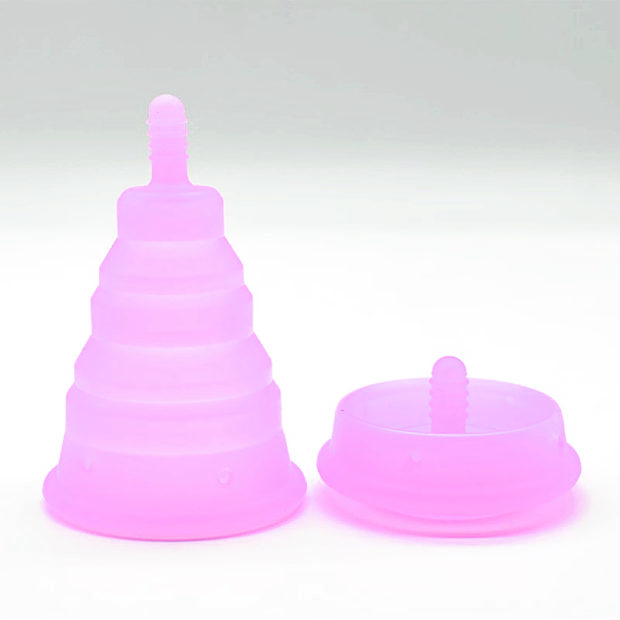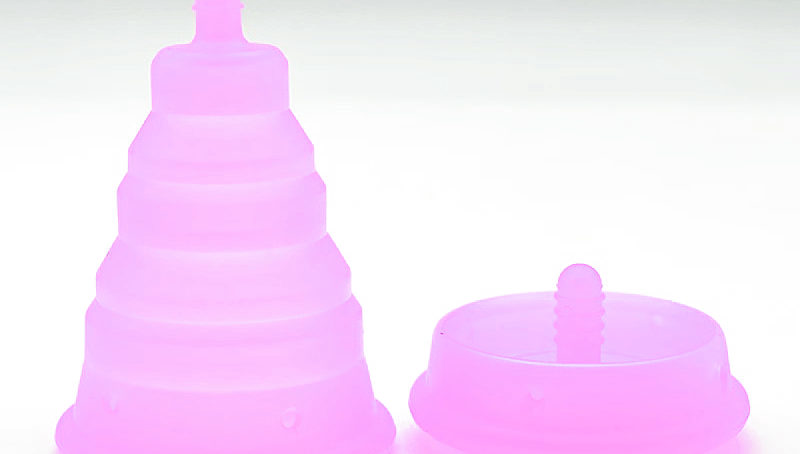There is a menstrual cup in our bathroom that has been staring at me for the past year and a half. I had been toying with the idea of making the switch to more eco-friendly feminine products for a while. What clinched it was when I was egged on by a colleague who said, with much enthusiasm, “It will change your life!”
But since it was delivered, it has sat on that shelf for only one reason: The menstrual cup really intimidates me.
Look at it. How, right? For a lifelong disposable sanitary pad user, so many questions and concerns flash through my mind: How do I put that thing in? What if it leaks? Do I just pull it out? How long can I use it? Is it safe?
In general, we’ve been made to think that “disposable” is the superior option—convenient, hygienic, cheap, readily available. Thankfully, these notions have been challenged in recent years. Globally, the conversation around single-use plastic has really opened up, with people becoming more aware of (and horrified by) the trash they produce. For women, that includes feminine products—sanitary pads, tampons, liners—most of which are composed of up to 90-percent plastic.In 2018, the World Bank reported that the world’s total waste in 2016 amounted to 2.01 billion tons, 242 million of which was plastic. The Philippines is also the world’s third largest source of plastic leaking into the ocean, as per a 2015 study by Ocean Conservancy and McKinsey Center for Business and Environment. Eight percent of our plastic waste at the time was personal care products. Plus, the COVID-19 pandemic is still raging, so expect these numbers to spike—from masks, PPE and “safe” disposable options of everyday items.
On average, a female will have her period from age 10-12 until she’s 50-55. That’s a lot of plastic used monthly. Costs also add up, and for many females the world over, pads and tampons take a backseat to other basic needs.
Reusable feminine products are not new concepts. The menstrual cup was invented in 1937, made of aluminum or hard rubber. Ancient Greeks used menstrual cloth. A patent for “sanitary bloomers” lined with rubber appeared in the early 1900s.
Today’s modern eco-friendly alternatives are comfier, and safe to use. But, like me, females still have a lot of questions. In an effort to demystify the available options, I’ve put together a list that will, hopefully, provide some answers.
Menstrual cup
Made of: medical grade silicone
Good to know: Sizing can be tricky.
Sizing: Small and large. Large is recommended for those with higher cervixes, heavy flows, who have given birth naturally, or are 35 up. If you have a lower cervix, a larger cup may protrude from the bottom. Some brands advocate trimming the stem. To accurately measure your cervix, see your doctor.
How to use:1. Wash cup with mild soap. Sterilize in boiling water for 5-10 minutes. Clean hands before inserting or removing cup.
2. To insert, fold cup and grip tightly. Fold it into a “C” (the C-Fold) or “punch it down” (the “Punch Down” or V-Fold).
3. Cup should unfurl itself once inside. You may have to vary the angle to get comfy and prevent leaks.

4. To adjust, use a finger to move it or rotate it with the stem or base.
5. Make sure it’s “sealed” along your vaginal walls. Lightly tug at the stem or base to check suction.
6. To remove, pinch base and remove slowly to avoid spills. You may flex your muscles down there as if having a bowel movement, or doing Kegel exercises. Dump contents into toilet or drain. If immediately reinserting, wipe down cup with clean tissue. Wash as soon as possible.
When to change: every 4-12 hours
How to clean: Wash with mild soap and water, then sterilize.
How to store: in a clean cotton bag
How often to replace: after 2-10 years
Where to buy:Sinaya Cup, sinayacup.com, P1,199
Aunt Flo, auntflocups.com, P995
Loop Store, loopstore.ph, P750
Simula, simula.ph, P300
Period Supply Co., periodsupply.com, P1,000-P2,850
Intimina PH, intimina.ph, P1,380-P2,000
Sati Cup, Shopee or @saticup, P950
Comfort Cup, comfortcupph.com, P899
Period panties
Made of: usually spandex/cotton/bamboo blends, with multiple layers to absorb your flow, and barriers to keep you comfy
Good to know: Some brands instruct users to wear the panties with a pad, liner or cup. Become familiar with your flow, so you know which days to supplement with another product, if you must at all. Do a test run at home first. A plus: heavy-duty period panties are also useful for postpartum bleeding.
How to use: wear and go
When to change: as needed
How to clean: launder like regular underwear. If concerned about stains getting on other items, rinse first. Air dry. Do not iron or use bleach or softener. For odors, soak in water and vinegar before laundering.
When to replace: after 2-5 years
Where to buy: Mirko, Shopee, @mirko_ph on Instagram, P250-P675
Bare Bone Store, barebone.store, P1,060/2
Her Belle and Beauty, herbnbph.com, P1,499-P2,999
Reusable pads and liners
Made of: layers of absorbent cloth, usually with a special layer for odor control or stain resistance
Sizing: Most brands will have different length options.
Good to know: There are charcoal options meant to trap odor. If you’re going to be out for a long time, you might have to carry around used pads with you, so keep a container in your bag.
How to use: Pad will have snaps, studs, buttons, hooks or strips to keep it in place
When to change: as needed
How to clean: Rinse or soak pad first. Hand wash with mild soap or detergent. Machine washing is OK for some brands. Do not iron, bleach or use softener. Avoid excessive wringing, which may damage the waterproof layer. Hydrogen peroxide may be used for stains; vinegar for odors.
How to store: Pads must be completely dry before storing to avoid mold. Immediately dispose of pads if mold develops.
When to replace: after 3-5 years
Where to buy:Ka Nami, kanamipasador.ph, P90-P274
Aunt Flo, auntflocups.com, P225
Simula, simula.ph, P120-P200Greenpads, @greenpadsph on Instagram, P80-P160—CONTRIBUTED INQ













































